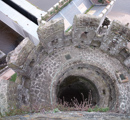From The Neolithic To The Sea: A Journey From The Past To The Present
Conwy Castle
Statistics
Category
County
Coordinates
Grid
Condition
Age
Admission
County
Coordinates
Grid
Condition
Age
Admission
Castle
Conwy
53°16'48.2"N 3°49'32.2"W
Ruin
1283
£
Conwy
53°16'48.2"N 3°49'32.2"W
Ruin
1283
£
Map
- History
- Gallery
- Gallery
- Gallery
- Gallery
- Gallery
- Gallery
Conwy Castle is a mediaeval castle located in Conwy. It was built to secure and control the crossing of Conwy River.
The castles construction was started in 1283 , by Edward I, during his conquest of Wales. It was finished in 1289, complete with a fortified wall surrounding the new town. It was besieged by Madog ap Llywelyn in 1294 - 95 and was resupplied by sea, until a sizable force came to its aid in 1295. After this rebellion was put down, the castle became the main residence of visiting senior figures. In 1301, Edward II visited the caste to receive homage from the Welsh.
The castle fell into disrepair and by 1321, it was reported to have rotten timbers and water ingress. Edward repaired and resupplied the castle in 1343.
In 1399, Richard II used the castle as a refuge from Henry Bolingbroke, meeting Henry Percy to negotiate his surrender. Afterwards he was taken to London, dieing later in captivity at Pontefract castle.
In 1401, Gwilym and Rhys ap Tudur took control of the castle, they pretended to be carpenters and after gaining entry, killing the guards. Welsh rebels captured the rest of the walled town and they held the castle for over three months. They surrendered to Henry with the guarantee of a royal pardon.
In 1642, Conwy was occupied by forces loyal to Charles I. They held out until 1646 when they surrendered to the Parliamentarians. The castle was then slighted to prevent it being used in any further revolt. In 1665, all the iron and lead was stripped and sold.
Conwy became a destination for painters and artists in the late 18th and early 19th century. Today, the castle is open to the public and is managed by Cadw.
The castles construction was started in 1283 , by Edward I, during his conquest of Wales. It was finished in 1289, complete with a fortified wall surrounding the new town. It was besieged by Madog ap Llywelyn in 1294 - 95 and was resupplied by sea, until a sizable force came to its aid in 1295. After this rebellion was put down, the castle became the main residence of visiting senior figures. In 1301, Edward II visited the caste to receive homage from the Welsh.
The castle fell into disrepair and by 1321, it was reported to have rotten timbers and water ingress. Edward repaired and resupplied the castle in 1343.
In 1399, Richard II used the castle as a refuge from Henry Bolingbroke, meeting Henry Percy to negotiate his surrender. Afterwards he was taken to London, dieing later in captivity at Pontefract castle.
In 1401, Gwilym and Rhys ap Tudur took control of the castle, they pretended to be carpenters and after gaining entry, killing the guards. Welsh rebels captured the rest of the walled town and they held the castle for over three months. They surrendered to Henry with the guarantee of a royal pardon.
In 1642, Conwy was occupied by forces loyal to Charles I. They held out until 1646 when they surrendered to the Parliamentarians. The castle was then slighted to prevent it being used in any further revolt. In 1665, all the iron and lead was stripped and sold.
Conwy became a destination for painters and artists in the late 18th and early 19th century. Today, the castle is open to the public and is managed by Cadw.



















































































































